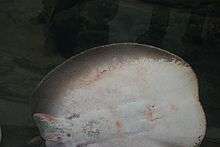Paratrygon
| Paratrygon | |
|---|---|
 | |
| Paratrygon aiereba at Shedd Aquarium, showing its underside and concave snout (to the right on photo) | |
| Scientific classification | |
| Kingdom: | Animalia |
| Phylum: | Chordata |
| Class: | Chondrichthyes |
| Subclass: | Elasmobranchii |
| Order: | Myliobatiformes |
| Family: | Potamotrygonidae |
| Genus: | Paratrygon A. H. A. Duméril, 1865 |
| Species: | P. aiereba |
| Binomial name | |
| Paratrygon aiereba (Müller & Henle, 1841) | |
Paratrygon is a monotypic genus of the cartilaginous fish in the family of Potamotrygonidae. The sole currently recognized species is Paratrygon aiereba, the discus ray, manzana ray or ceja ray, from the Amazon and Orinoco basins in South American.[1][2] Genetic evidence suggests that P. aiereba as presently defined is a species complex.[3][4]
Appearance
This freshwater ray has small eyes and a disc shaped roughly like a lily pad (the snout is slightly concave).[3] It is brownish above with a dark vermiculated or reticulated pattern.[3] It reaches up to 1.6 m (5.2 ft) in disc width and 110 kg (240 lb) in weight, making it one of the largest species in the family.[3] There are unconfirmed claims of much larger individuals, but these are considered highly questionable.[5] Most individuals do not surpass a disc width of 1.3 m (4.3 ft).[3] Males reach maturity at a disc width of about 60 cm (2.0 ft) and females at about 72 cm (2.4 ft).[1]
Behavior
It mainly feeds on fish,[6] but also take invertebrates such as insects and crustaceans,[1][3] and it is a top predator in its habitat.[7] Adults are found in relatively deep waters in main river channels, but move to shallower waters to feed at night.[1] After a nine-month gestation, the female give birth to an average of two young with a disc width of about 16 cm (6.3 in).[1] Juveniles are found in relatively shallow waters at sandy beaches and in creeks.[1][3]
References
- 1 2 3 4 5 6 7 Góes de Araújo, M.L. & Rincón, G. (2009). "Paratrygon aiereba". IUCN Red List of Threatened Species. Version 3.1 (3.1). International Union for Conservation of Nature. Retrieved 21 February 2017.
- ↑ "Paratrygon aiereba summary page". FishBase. Retrieved 2016-01-12.
- 1 2 3 4 5 6 7 Last; White; de Carvalho; Séret; Stehmann; and Naylor, eds. (2016). Rays of the World. CSIRO. p. 626. ISBN 9780643109148.
- ↑ Frederico; Farias; Góes de Araújo; Charvet-Almeida; & Alves-Gomes (2012). Phylogeography and conservation genetics of the Amazonian freshwater stingray Paratrygon aiereba Müller & Henle, 1841 (Chondrichthyes: Potamotrygonidae). Neotrop. Ichthyol. 10(1).
- ↑ "Paratrygon aiereba". fishing-worldrecords.com. Retrieved 25 October 2017.
- ↑ Reynolds; Hornbrook; Stettner; and Terrell (2017). Smith; Warmolts; Thoney; Hueter; Murray and Ezcurra, eds. Husbandry of freshwater stingrays. Elasmobranch Husbandry Manual II. Special Publication of the Ohio Biological Survey. pp. 99–112. ISBN 978-0-86727-166-9.
- ↑ Rosa, R.S.; Charvet-Almeida, P.; and Quijada, C.C.D. (2010). Carrier, J.C.; Musick, J.A.; and Heithaus, M.R., eds. Biology of the South American Potamotrygonid Stingrays. Sharks and Their Relatives II: Biodiversity, Adaptive Physiology, and Conservation. CRC Press. pp. 241–285. doi:10.1201/9781420080483-c5.
| Wikimedia Commons has media related to Paratrygon ajereba. |
